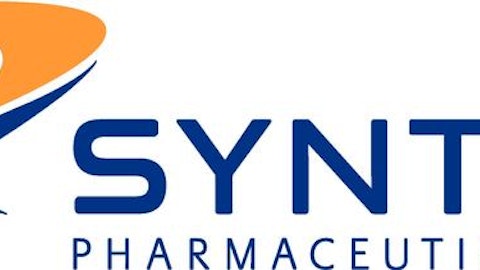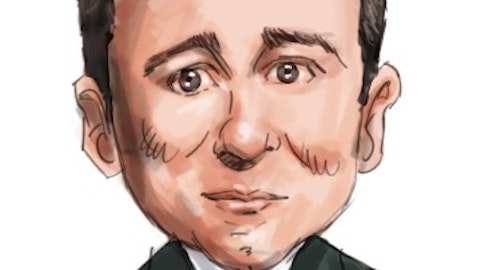Aris Kekedjian : Well, look, we had a previous — I’ll let John give you a little bit of a kind of a forecast or a perspective on those numbers and what they could potentially be. But look, the variant product is replacing a market leadership position we had historically and expect to kind of hit the same rates once this product is rolled out. It’s really a much better version of the Ultra product we had in the market, right, John? So where are we on the Ultra roughly in the ballpark?
John Gillard : Yes. Well over $5 million to $6 million revenue a year, right, in the U.S. predominantly with very healthy margins, Paul, right, and a recurring revenue model. We could get higher to that, obviously, to the extent that we push this outside the U.S. So while we have launched it under CE Mark in a lot of countries because it’s a U.S. manufactured product, it needs 510(k) approval, that needs home country approval. And just also from a marketing and credibility perspective, right? One of Trinity’s great strength in its other areas is the fact that it has a large number of 510(k) approved products, right? And that markets those products well outside the U.S. And the same should apply for the Premier Resolution. So yes, look, we’d hope to be getting 5 or 6, if not more, million a year out of that at a good margin.
And really, the growth is only dictated by, I suppose, how far we can expand that outside of the U.S. of which the 510(k) is a key pillar in that strategy.
Paul Nouri : Okay. And then shifting to the screening market. In Africa, how much does — how much market share does the current leader have there approximately? I know it varies country by country. But are they predominant over 50%? Or is it more of a scattered market than that?
John Gillard : Yes. Look, I don’t think we’d want to necessarily talk about someone else’s market share. We’re more interested in our own. But the — yes, they have a predominant position within the market. And —
Paul Nouri : I’ll let roll over kind of what you targeted. So yes.
John Gillard : Yes. But that gives us an opportunity, Paul, to pick up a meaningful piece of that market. They have been the incumbent there for many, many years, and that gives an opportunity with our product, which we think has key benefits in terms of its performance. But also the time to test, it’s a faster test to run and that matters a lot where you’re running a HIV testing clinic in terms of throughput. So we think that we can pick up a meaningful piece of that market, notwithstanding their position there.
Paul Nouri : And do you anticipate that legal objections might be an issue in each country? Or is this country unique in some way that they thought that they had a like to stand on?
John Gillard : Look, but again, not inclined to talk about cases that other parties are involved with and we’re not involved with. But I’d say this was not necessarily an issue that we had perceived would be a problem in terms of a broader ro2llout in Africa. So we don’t foresee it as a major issue.
Aris Kekedjian : I’ll give you my perspective on it having done a fair bit of business in Africa. Look, just one step back, we’re talking in our screening market about $150 million a year roughly, okay, of revenue available in the market given the attributes of our tests, and they are substantial, and the desire for many countries to have an alternative on their algorithms. It doesn’t — it’s — we’re not planning to kind of go get 50% of the market or anything like that, but it isn’t inconceivable for us to have 20% of that market at all. I think that’s doable. So that will give you some context of sizing around that for now. And then the other thing I would say is whether it’s a legal case, sometimes it’s a political issue, Africa is lumpy, and it’s going to be lumpy.
That’s one of the main reasons why we’re focusing our point-of-care test to scale beyond Africa into higher margin, more predictable markets, okay? At the same time, we brought Tom Lindsay on board, and Tom built Alere’s business in Africa. He’s got the networks. He’s got to grab it to us. It’s one of the main reasons we brought him in, to enhance our transparency and overall intelligence around dealing in Africa and getting more predictability out of it. So all those are the best things we can do, but it’s always going to be lumpy out of Africa, and we just have to accept that.
Paul Nouri : Okay. And I know this is kind of a tough question because there’s no way that you can predict this kind of thing. But as you’re looking for partners to possibly merge with or whatever the strategic combination would be. Are you leaning more towards younger companies who have more capital and could use the fact that Trinity has been in the market so long? Or is it the other way around where you’re looking for more mature companies or maybe looking to just bolt on some extra product lines or whatnot?
Aris Kekedjian : Look, I would say we’re looking at a range, okay? We’re looking at companies that might be similar to us and have what I would find an appealing product pipeline in the point-of-care space. That could be interesting to us. We are talking to companies that are plugged in to the new healthcare treatment ecosystem with telehealth and all the other digital providers being sponsored by payers and who are connected to these networks through user interfaces, APIs, abilities to do private label, very interesting IT capabilities among other things, that are really important if you’re going to try to fulfill solutions in a point — especially over-the-counter B2B2C models and over-the-counter strategy. So those tend to be, what I would call, yes, younger companies, more techy companies potentially, but who get healthcare and who get the complexity being plugged into healthcare.
And then I think the third category would be traditional CPG companies and tech companies who are — who see this as a real growth opportunity for them. And what I like about those discussions is we don’t have that kind of distribution reach, they do, and they don’t have the regulatory and operating excellence in this industry that you need to have that we do. So I think there’s some very interesting dialogues going on. But that’s the range of conversations. John, I don’t know if you want to add anything to that.
John Gillard : So I think that’s a fair summary. Like Paul, really what we’re — what we’re trying to do is in a post COVID world, we have a capability for developing manufacturing point-of-care tests. And now we think we can direct towards the more over-the-counter higher price point consumer market. And our laboratory also, we can redirect that capability to serve that market to support virtually payers. So it’s really around us taking our existing capabilities and looking to scale them and point them at higher price point, higher margin opportunities than we have been maybe over the last 12. And so they —
Aris Kekedjian : Look, we’ve had inbounds for people wanting to — digital companies who’ve been wanting to spend a fair bit of money, wanting to buy our lab business. The reality is we realized we actually have something interesting and allows us — this allows us to lead in terms of the interconnectedness you need to have to this ecosystem. And the margins, I got to tell you, are a lot higher, a lot higher.
John Gillard : Yes, through some extent, there’s capabilities we need to bring in to do that and partnerships and M&A are a way for us to do that as well as building on our existing platform with product acquisition or synergy plays.
Aris Kekedjian : Look, you’ve got a fundamental — aside from user references that have all evolved and companies like Apple who want to get into healthcare and CVS and everybody wants — everyone wants bloody results if they can get it. What’s the most important trend is that payers have had enough, right? And payers are driving digital health. And everybody knows that progressive proactive testing is critical to make this work. The ecosystem is looking for solutions. We’re a piece of that solution, okay? And what we’re figuring out is how do we plug what we’re good at with people who have other aspects of what this ecosystem needs to provide solutions because the payers, the insurance guys, they were just — they’re looking to put together programs to get ahead of the cost issue.
So we’re just being smart about this. We’re not trying to be something we’re not. Some things, we’ll buy. I’m very interested in buying user interface, user experience opportunities or partnering around that kind of thing to plug in with our lab and product capabilities. I think that positions us very, very well. And so look, stay tuned.




